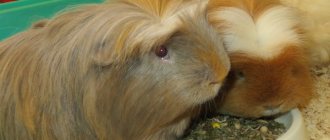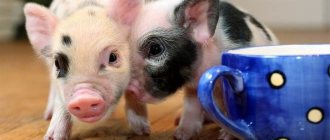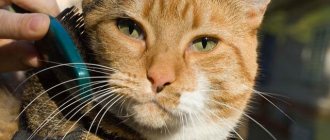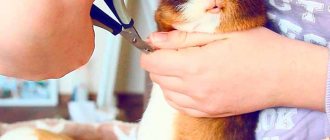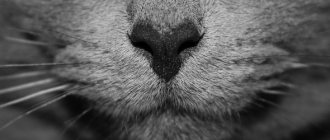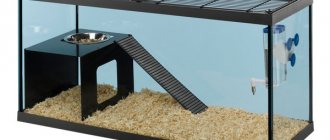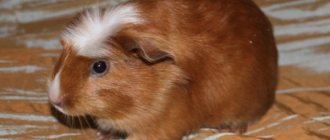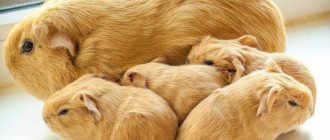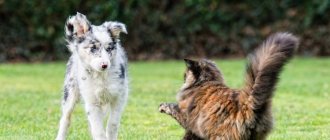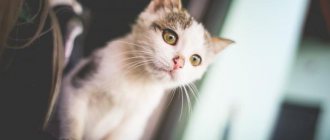In some ways, the guinea pig is a unique animal. And it’s not just about her intelligence and ability to recognize her owner. She can boast of a special skeletal structure. Therefore, before buying a pet rodent, you need to learn about the structure of its body, the characteristics of life in the wild, its dietary preferences and care rules.
This information will help the future owner not to make mistakes that could adversely affect the health of the animal.
What types of guinea pigs are there?
There are several organizations in the world that set standards for rodents. We will focus on the classification Standard for the judging of all cavy breeds as recognized by the European Association of the European Association of Breeders of Poultry, Pigeons, Ornamental Birds, Rabbits and Guinea Pigs.
Pets come in different colors: white, red, cream, black, chocolate and more. There are also spotted individuals. The eyes are black, pink or dark ruby.
Experts divide guinea pig species into three groups based on their coat structure.
Wire-haired guinea pigs
This category includes six species of animal.
- Satin . The rodent's fur is thick and short. Hair shines thanks to its special structure. Their color can be any.
- Crested . The body is covered with smooth and short fur. There is a tuft on the forehead. It is sometimes called a rosette.
- Rex. Rodents have elastic, corrugated fur that stands up straight. The hairs are short and rough to the touch. The mustache is curly.
- Abyssinian. The body is evenly covered with “rosettes”; there can be 10–12 of them. The length of the coat is approximately 3.5 cm.
- American Teddy. The fur is plush and soft. The length of the hairs is at least 2 cm. The belly of young individuals is curly, but this goes away with age. The mustache is straight.
- Swiss Teddy. The wool is rough and crimped. Its length on the body reaches 6 cm. With light contact, the hairs should show elasticity and return to their previous appearance. The mustache is normally wavy.
Abyssinian guinea pig. Photo: Tettania / Shutterstock
Long-haired guinea pigs
There are seven varieties in this category.
- Peruvian. These guinea pigs have very long and soft fur. The bangs completely cover the muzzle.
- Sheltie. The hairs on the animal's head are short. Longer ones start on the cheeks and behind the ears. They grow from the muzzle and form a mane. The fur is silky to the touch.
- Coronet. There is a tuft on the forehead. The hair on the body is long, elastic and soft.
- Alpaca. The rodent has two “rosettes” on its back. The fur is curly. The mustache is normally curly.
- Texel. Long curls on the body. They are directed from the head to the sacrum. The hair on the face is short and crimped.
- Merino. There is a rosette on the animal's forehead. The head is smooth-haired. The longer fur starts behind the ears.
- Lunkaria. The coat is curly and harsh. This makes such a guinea pig look like a sheep. There are two “rosettes” on the sacrum.
Guinea pig coronet. Photo: Pernille Westh/Shutterstock
Smooth-haired guinea pigs
These animals have short and shiny fur. It grows from the head to the back of the body. The length of an individual hair is slightly more than 2 cm. Varieties of rodents differ in color, which are divided into several groups.
- Plain. The body, belly, paws and muzzle of the rodent are covered with fur of the same color.
- Agouti. The animal's fur throughout the body, except the belly, is ticked. This means that each hair has alternating areas of different colors.
- Total agouti. It differs from the previous type only in that there are ticked hairs even on the belly.
- Argent. Guinea pigs with this color also have ticked fur on their bodies. There are no two-color hairs only on the abdomen. The main feature of the variety is dark ruby or pink eyes.
- Labeled . Areas of fur differ from each other in different colors.
Smooth-haired guinea pig with marked color. Photo: Robirensi/Shutterstock
Invasion of Japan
For the first time, Japanese scientists from the University of Hiroshima began to study this issue seriously. It was noticed that the waters of the Pacific coast of the Land of the Rising Sun are simply teeming with nomura jellyfish (Nemopilema nomurai). Experts became interested in this increase in population and decided to find out its reason.
During the research, they were faced with the need to thoroughly study the question of how jellyfish reproduce.
It was found that the cycle is quite complex. And after birth, giant jellyfish babies, like snowflakes, behave just as aggressively and have the same gluttony as adults.
What is the character of guinea pigs?
A guinea pig bonds with Guinea Pig: Species Profile to a person who takes care of it regularly. Many animals enjoy cuddling with their owners. Some individuals even begin to squeal with excitement when they see loved ones.
Like any pet, a rodent can sometimes get nervous. It rarely bites. If you play with him often, he will get used to it and will feel comfortable in a person's arms.
When exposed to other species, your guinea pig may panic. Special Considerations for Guinea Pigs. Therefore, keep her away from cats, dogs and other animals. This will also help prevent the spread of infections.
Remember: the company of people will never replace the company of animals like themselves. Therefore, it is recommended that Guinea Pig: Species Profile keep pets in pairs.
If you do not intend to breed guinea pigs, consider purchasing two of the same sex. It is believed that females are the best option. Males, especially those who are not castrated, sometimes fight.
Unlike rats and hamsters, guinea pigs are diurnal Special Considerations for Guinea Pigs. Therefore, at night they do not disturb their owners’ sleep.
Reproduction
A male guinea pig becomes sexually mature at 8-12 weeks, and a female at 7-8 weeks. But the recommended age for breeding is 10 months and older. Animals forming a pair must be healthy, of the same age and the same breed, but they must not be relatives.
It is advisable that fertilization occurs no later than November. Estrus in pigs lasts 2 days and repeats every 12-20 days. The best time for mating is the first 12 hours.
The duration of pregnancy is approximately 10 weeks. Multiple pregnancies are often accompanied by early delivery. The future mother pig needs complete rest - she should not be picked up, stroked or otherwise disturbed. Any excitement is fraught with miscarriage.
Delivery lasts no more than half an hour. Piglets appear at intervals of 3-4 minutes. One litter usually produces 1-5 babies.
What living conditions do guinea pigs require?
These are active animals, so they need a lot of space. It is best to place the rodent in a spacious cage. How to set up a Guinea Pig cage. The minimum floor area for one individual is 90 × 70 cm, for two - 120 × 70. The height of the home is 45 cm. Then the guinea pig can easily stand on its hind legs.
The bottom of the cage should be hard and smooth, for example plastic. The pet can damage its paws on the slatted floor. The walls of a good house are made of twigs: this ensures normal air circulation.
The How to Set Up the Perfect Guinea Pig Enclosure should not be placed in a draft, near radiators or in direct sunlight. The ideal temperature Special Considerations for Guinea Pigs in the room where rodents live is 18–23 degrees. If it rises above 29 degrees, your pet may suffer from heatstroke. Also try to maintain relatively low air humidity - up to 50%. The area around the cage should be quiet Guinea Pig: Species Profile. Loud noises and sudden movements often cause stress in guinea pigs.
What Do Guinea Pigs Need In Their Cage? nipple drinker. It is also worth buying ceramic bowls. Animals easily turn over plastic dishes.
Photo: Elena Sineglazova / Shutterstock
There should be enough shelters How to set up a Guinea Pig cage in the home so that all the guinea pigs can hide at the same time. Tunnels, houses or pipes will do.
How To Set Up A Guinea Pig Hutch bedding is usually placed on the floor of the hut. You can use paper or fleece. If you want to stick with pellet wood filler, choose aspen. It will absorb the animal's urine well. It is not recommended to buy cedar and pine shavings from Guinea pig housing. When wet, it sometimes releases vapors containing substances that irritate the animal's respiratory tract and paws. Straw won't work either. It can injure your pet's eyes.
What to feed guinea pigs
Guinea pigs are herbivores. The majority of their daily diet should be Feeding Guinea Pigs hay. A mixture of timothy and oats works best. Alfalfa should be given in small quantities. There is too much calcium in this grass.
If you throw food on the floor of your home, it will mix with the animal's feces. Therefore, some owners buy a hay box that is attached to the bars of the cage.
Photo: jessehr/Depositphotos
It is important that the hay is always fresh Feeding Guinea Pigs. Anything that smells musty should not be given. To prevent it from becoming moldy, you need to choose a storage place. A cool, dry environment is suitable.
You can't do without hay. What should I feed my guinea pigs? . It helps the guinea pig's intestines work properly. The rodent also wears down its teeth, which grow throughout its life.
In addition, vegetables and fruits should be included in the guinea pig's daily diet. This food is a good source of vitamin C. Here are some Feeding Guinea Pigs examples of what you can feed your animal:
- bananas;
- blueberry;
- cantaloupe;
- green peppers;
- strawberry;
- tomatoes;
- watermelon.
There should be more vegetables in a rodent's diet than fruits. All products should first be washed and cut into small pieces. After this, they can be placed in a bowl. If the treat is not eaten within a few hours, it should be thrown away. Rotten food What should I feed my guinea pigs? will only harm the guinea pig.
The animal also needs to be given greens and grass. Lettuce or dandelion leaves, marjoram, arugula, calendula, rosemary, dill, parsley, basil, and carrot tops are suitable.
Guinea pigs can also be fed special granulated food. Make sure the fiber content is at least 16%. But you shouldn’t make the ready-made mixture the basis of your diet.
A rodent should be accustomed to any new foods gradually. Increase the number of treats over two weeks. This will give the digestive system time to adjust and prevent the animal from getting sick.
Some foods seem harmless, but you should not give them to your animal. This is what causes serious What should I feed my guinea pigs? health problems:
- cereals;
- grains;
- nuts;
- seeds;
- dried beans;
- corn;
- buttercups;
- lilies;
- acorns and oak bark;
- avocado;
- rhubarb;
- onion;
- potato tops;
- mushrooms;
- bread;
- cookie;
- chocolate;
- pasta;
- pickled vegetables.
Make sure that the rodent has fresh water around the clock.
Games, training and taming a pet
When a pet first appears in the house, you should not immediately grab it and actively get to know it. This is a new place for the animal, so it needs to be given time to get used to it. As soon as the animal is brought into the house, it must immediately be put in a cage. The cage must have food, water and a house. The owner needs to approach the cage and talk gently to the pet, without making loud or harsh sounds. The next day, you can offer your pet a treat from your hand. If the animal comes up and treats itself, you can gently stroke it. At this time, the animal gets used to the voice and smell of the owner and learns to trust him. After the pet has approached its owner several times, it can be picked up.
When holding your pet for the first time, you need to be calm, confident and careful. If the first time you try to pick up a pet is unsuccessful, the animal falls or hits itself, then it will continue to have a fear of hands.
After the pet gets used to the new place and begins to actively communicate with the owner, you can teach him a few tricks. In order for the pet to respond to its name, every time the owner pours food or offers a treat, you need to call the pet by name. The animal will associate the vocal signal with the supply of food and will begin to approach when simply called.
It is a mistake to believe that guinea pigs are inactive and mostly sleep and eat. They enjoy playing, exploring outside the cage and walking on the green lawn. Pig games are the simplest, but most interesting. The simplest entertaining game is playing with a paper ball. The animal will like the rustling ball and will happily roll it around. Another simple but fun activity is a cardboard box. You need to make holes in a small box and put it in a cage or enclosure for the pig. The pet will happily climb in and out of the box until it gets tired. To entertain the animal, you can also hang a hammock, build a tunnel, or let it chew on a branch of a fruit tree.
Activities for cute rodents include walking around the apartment or walking outside. To do this, you need to make sure that the space is safe and warn everyone that the small animal is “on the loose.” And when walking on the street, you will have to constantly monitor the animal so that it does not fall into the paws of a cat or dog.
How to care for a guinea pig
Unlike dogs and cats, rodents require minimal care. There are several Grooming Care for Your Guinea Pig tips that will help make your pet's life more comfortable.
Trim your nails
The procedure is performed on all guinea pigs. The frequency depends on the rate of claw regrowth. In young individuals with a balanced diet, this happens faster than in older ones. For trimming, you will need special nail clippers; you can buy them at a pet store.
To do everything correctly, look at the claw in the light. You will see a translucent tip, you need to cut it off. Just above the process is the pink part. There are blood vessels there, you can’t touch them. If this does happen, take a paper towel, place it on the wound and press it for a few minutes.
The procedure can be carried out conveniently by two people. One person holds the pet by the stomach and presses it tightly to his body so that the paws do not dangle. The second one cuts his claws. If there is no one to help, the owner can wrap the guinea pig in a towel and hold it under one arm. The fingers remain free.
If the animal is nervous, you should interrupt the procedure and continue later. But most rodents still tolerate having their nails trimmed when they are distracted by food.
Get out of the cage
The pet needs cleanliness. If the home is dirty, the animal may develop How to Clean a Guinea Pig Cage respiratory disease.
Every day, remove those parts of the litter that have already absorbed urine. Then add fresh one. You can use a small spatula.
Once a week, remove shelters, bowls and water bottles from the cage. Treat them with a non-toxic cleaner from a pet store. Wipe down the house itself. Replace all filler with fresh one.
Comb the animal
Rodents with short hair are brushed with Grooming Care for Your Guinea Pig with a soft brush once a week. This keeps shedding to a minimum. Inspect the rodent during the procedure. If you notice ticks, fleas, scratches or scabs, you should contact your veterinarian.
Long-haired pigs are brushed several times a week. This helps avoid tangles. Fine-tooth combs work best for this.
Bathe occasionally
Let's say right away that they bathe the animal only in extreme cases. Grooming Care for Your Guinea Pig. For example, if your guinea pig gets dirty due to diarrhea. In such a situation, the contaminated area should be washed with warm water and animal shampoo. After this, pat the wool dry with a towel.
The main mistakes in caring for land turtles
Follow the rules of care and then your pet will delight you with its good mood and health
People often buy turtles without thinking about the care they require. The most common mistakes in keeping reptiles:
- Lack of a terrarium as such. Unfortunately, most people buy reptiles, forgetting about the arrangement of their habitat. They let them crawl around the house, without providing any temperature control or other comfortable living conditions for the pet.
- No UV lamp. Not all owners are aware of the extreme necessity of ultraviolet radiation for the health of their pet. If there is no such lamp, problems arise with the baby’s shell and health.
- Cleaning your pet with a stiff brush when shedding. Bathing should not be accompanied by any additional cleaning products or brushes. After bathing, wipe dry with a soft towel.
- Keeping several pets in one terrarium. Doing this is strictly prohibited. Two males in the same area or animals of different sizes will definitely start a war for territory.
- Washing the terrarium in the sink with kitchen utensils. It’s best to do all the cleaning outside of the kitchen. The use of a kitchen sponge is also undesirable for hygienic purposes. It is better to prepare a separate set of rags and sponges for cleaning the animal’s home, and after this procedure, thoroughly disinfect the sink.
Wash your hands thoroughly with soap!
The turtle is a wonderful, unpretentious pet. With proper care and feeding, he will delight his owners for many years. Many people love to watch their pet bask in the sun and take it with them to the dacha for a walk on the grass. And for some, arranging a reptile’s place of residence turns into a real hobby. If you don’t want to waste time on walks and constant fussing with the animal, a turtle is the best choice to purchase.
What do guinea pigs get sick of?
The condition of the animal must be monitored. Sometimes rodents develop such abnormalities Common Guinea Pig Illnesses.
Diarrhea
It may appear due to a bacterial infection of the intestine or when the animal eats a lot of watery foods. In any case, you need to remove fruits and vegetables from your guinea pig’s diet and add hay. Then the rodent should be taken to the veterinarian.
Dental problems
As we have already said, a rodent's teeth grow throughout its life. If the animal doesn't wear them well, they can become too long. Because of this, some individuals begin to refuse food. Check your guinea pig's mouth every week to help identify problems early. As a preventive measure, you can give your animal chewing sticks from a pet store. In advanced cases, the teeth are trimmed by a veterinarian.
Ticks
Some penetrate the skin and cause irritation. The animal begins to itch. Because of this, the skin turns red and the hair falls out. Recommendations for treatment are given by a veterinarian. Regardless of the remedy that the doctor recommends, the owner must clean the cage. This will help avoid problems in the future.
Respiratory infections
Pneumonia or other illness may occur due to too humid air. The deviation is easy to recognize: the animal wheezes and seems lethargic. These symptoms are a reason to consult a veterinarian as soon as possible.
Scurvy
The animal may lose weight. Sometimes diarrhea and problems with the musculoskeletal system appear. To help the rodent, experts recommend introducing additional foods and vitamin C supplements into the diet.
Cystitis
Females are especially prone to the disease. The abnormality can be noticed by blood in the urine. Sometimes guinea pigs stop urinating completely, so it is important to monitor the litter in the cage.
Diseases
The animal does not get sick often, but when the first signs are detected, it is necessary to begin treatment. It is better to trust a professional doctor who will select the optimal treatment.
The most common diseases are: worms and parasites, gastrointestinal disorders, colds, dental anomalies and eye infections.
What to look for when buying a guinea pig
The animal can be purchased at a pet store, nursery or from a breeder. Before picking up your pet, check Guinea Pig: Species Profile for the conditions and health of the individual.
Make sure males and females are in separate cages. If they are kept together, you can bring home a pregnant guinea pig.
Observe how the animal you like behaves in the house. Normally he is active and alert. Pick up the rodent and examine it. When everything is good, the fur is clean and without bald spots. There are no redness or scales on the skin. There is no fluid leaking from the ears, eyes, nose or anus. The body is round and strong.
If the animal seems too quiet, refuse the purchase. Your guinea pig may be sick.
Habits
In most cases, very calm and affectionate animals. Rodents show their character in an unusual way. If they are happy, they may jump around the cage and make squeaking noises.
Small individuals are afraid of people and constantly hide in a safe place. It is necessary to accustom the animal to hands carefully without stress.
Aggression manifests itself only after the birth of offspring. For a month, the female will not let anyone near the babies and will defend herself in all known ways.
If the pig is chewing on the cage, then it is bored or there is not enough space. You can expand the cage, play more often, or add another individual. It is dangerous to chew on a cage.
The norm for these animals is to eat their own droppings. Thus, the animal saturates its body with the remaining beneficial substances.
But it’s better to clean the cage in time and expand the diet with vitamins. Your pig may chatter his teeth, which is a sign of stress. It is necessary to temporarily remove irritants.
